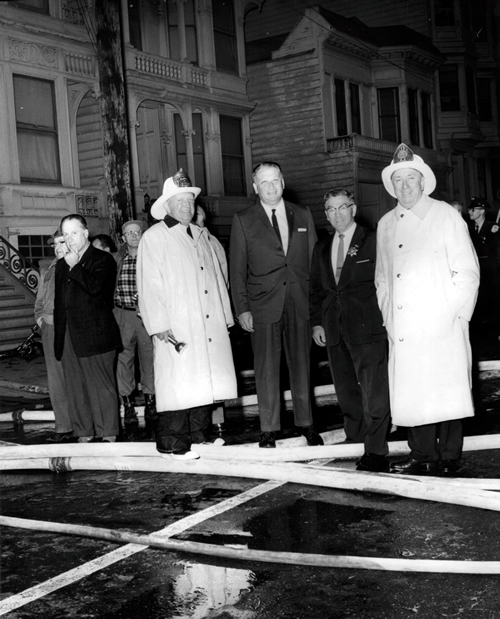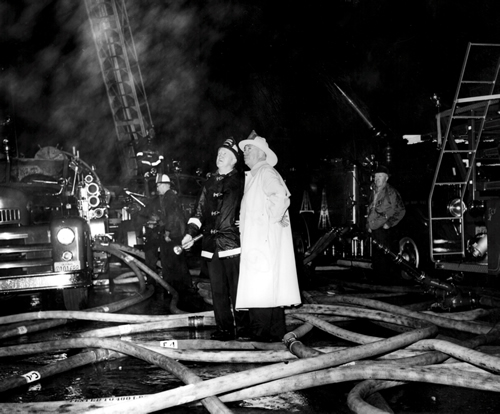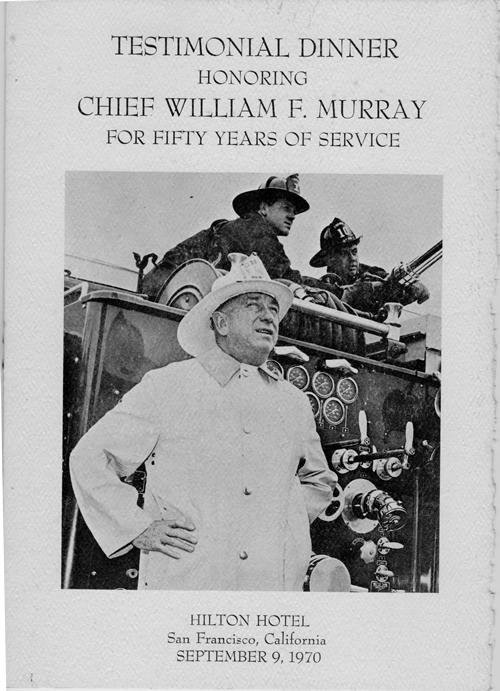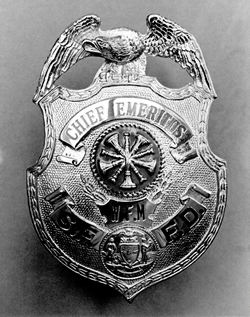
- Guardians Home
- SFFD Home
- Site Map
- Historical Review
- Apparatus
- Chiefs of Department
- Chronology
- Charles H. Ackerson
- Charles J. Brennan
- Keith P. Calden
- Andrew C. Casper
- Emmet C. Condon
- Robert L. Demmons
- John H. Dougherty
- Charles P. Duane
- Joanne M. Hayes-White
- George H. Hossefross
- Francis P. Kelly
- Frederick D. Kohler
- Joseph A. Medina
- Thomas R. Murphy
- William F. Murray
- Jeanine Nicholson
- Edward J. Phipps
- David Scannell
- Patrick H. Shaughnessy
- Albert J. Sullivan
- Dennis T. Sullivan
- Paul J. Tabacco
- Mario H. Trevino
- Edward P. Walsh
- Franklin E. R. Whitney
- Companies
- Events
- Past Events
- SFFD 150th Anniversary
- PPIE 100th Anniversary
- 1906 Expo
- 1989 Quake Party - 2009
- 65' Ladder Presentations
- Broderick & Terry Duel
- Coit Tower 75th Anniversary
- Cole Valley Fair
- Gold Hydrant - April 18th
- Jimmy's Car Show
- Lower Haight Street Fair
- Lotta's Fountain - April 18th
- Musters
- Presidio Car Show
- Station 28 75th Anniversary
- Fireboats
- Firehorses
- Firehouses
- Fires
- In The Line Of Duty
- Museum Collections
- Musters
- Notable People
- Organizations
- Gift Shop
- Volunteers
- Related Links
- Contact Us
- Research Requests
- Photo Gallery
- Videos
- Donations
| Chief Engineers - Chiefs of Department: William F. MurrayChief of Department
1956 - 1971 January 17, 1984, bestowed the title of "Chief Emeritus, San Francisco Fire Department"   12-6-1962, 3rd Alarm, 244 Folsom Street  3-21-1965, 5th Alarm, Gibraltar Warehouse on left: Chief's Operator John Sherran
- The son of John Murray, Captain, SFFD, Engine Co. No. 1 - Chief Murray's son, William J. Murray, was a member of the Department and retired at the rank of Captain. He later served in the Glen Ellen Volunteer Fire Department, including as volunteer fire chief. - Chief Murray's grandsons served in the California Department of Forestry and Fire Prevention (Cal Fire), during college. One of his great grandsons also served in that capacity. Highlights of his tenure as Chief of Department:
Chief Murray was well liked and respected by all members of the department. He had a presence and stature of a born leader. Chief Murray responded to third alarms of fire and all other major incidents. The Chief delegated his deputy chief to run the fire while he handled the press. This was at a time when each of the City's four newspapers sent reporters and photographers to fires, radio stations wanted a recorded statement, and television was just beginning to have live reports from these events. There was always a large press contingent gathered around the Chief. Today every department has a Public Information Officer to give reports to the press. Chief Murray must have been the example used in today's job description for a PIO. Chet Born, the Fire Department photographer said: "The Chief was the only person that he photographed who always knew when a camera was pointed at him. He would quickly and easily turn into that camera. He was very easy to capture on film." Chief Murray's clarity and honesty with the press made sure that the Department image was held in high regard. At this same time the firefighters of the Department, mostly World War II veterans, were making unbelievable fire ground accomplishments that established the SFFD as one of the best departments in the nation, if not the world. When the Department was changing over from horse drawn apparatus to motorized units, Chief Murray was one of the few members of the Department who had ever driven a car or a truck. One of his first assignments was to train other members how to drive the new motorized apparatus. With only one year of service he was assigned to the driver's position of Engine Company 21. Normally it takes years before a fireman is assigned as a driver. As the first months passed after he was appointed the Chief of Department significant changes took place, it became evident that the Department was progressing on a carefully planned schedule. Initially, attention was directed toward revising and delegating administrative and staff activities into efficiently functioning divisions, capable of guiding and coordinating the developing program. This resulted eventually in the Specialized Auxiliary Service, comprising the Divisions of Training, Administration, Fire Prevention, and Special Services, each headed by an Assistant Chief. The Division of Training was expanded to prepare for a departure from the traditional practice of placing new recruits directly into fire stations. On April 22, 1957, a class of new recruits started the first eight week probationary training program at the Fire College. This training program had to be completed satisfactorily before assignment to actual fire duty. This period of training has gradually been increased to twelve weeks. Successful completion of a final examination at the end of six months remains a prerequisite to permanent appointment. A comprehensive training manual program was also developed to fill the lack of written training and procedure guides. This program, under the guidance of the Chief, culminated eventually into more than twenty manuals covering all phases of specialized knowledge considered necessary for efficient practices. The year 1958 marked the beginning of a sweeping program designed to replace all in-service dual pumpers and tank wagons with the new triple-combination pumper which consolidated the functions of both pieces in one unit. On August 20, 1958 on orders of Chief Murray the program began when Engine Company 6 was replaced with Triple Combination #1. By May of 1961 twenty of the new "triples" were in service and the last tank wagon had been inactivated. All S.F.F.D. pumpers acquired in 1963 and thereafter were required to have a minimum rated capacity of 1250 G.P.M. Replacement of the old City Service Trucks with modern aerial on a one-a-year basis had also been instituted as part of an overall planned program to fully equip the Department with triple pumpers and aerial ladder trucks by the fiscal year 1968-69. A program to equip all apparatus with self-contained breathing equipment had its inception during the first month of Chief Murray's tenure. A severe fire on New Year's Eve of 1956 felled over one hundred firemen from smoke and toxic gases before control could be established. Immediately thereafter the Chief pushed through an emergency appropriation for seventy-five units of self-contained breathing equipment. The Division of Administration, created on July 1, 1961 by Chief Murray was designed to receive, review, and process all relevant Department business. Routine matters are usually resolved at this level, those of more importance being reserved for the attention of the Chief or Deputy Chief. A great part of the work load of the Division of Administration is channeled through the Bureau of Assignments and Communications, a supporting unit which executes all matters relating to personnel, dispatching, communications, and information services. Two major changes have been instrumental in bringing the Bureau of Assignments to the high level of efficiency at which it operates today. The first, occurring November 7, 1962, was the assumption of responsibility by experienced Fire Department officers for receiving fire calls and controlling all emergency dispatching. This has resolved the conflict caused by the former practice of Department of Electricity members handling this function. The second event was the completion of installation of two-way radio on all first line Fire Department equipment. Under the guidance of a Communications Committee appointed by Chief Murray, the existing radio equipment had been surveyed and a decision made to install a wider range, multi-channel system. This program, started in 1958 and finally completed in May, 1963, allows the Department to function with much greater speed and flexibility both in routine activities and emergency response. With radio control finally achieved it was possible to institute the successful Fire Safety Survey Program. This program is an ambitious plan to have department members visit all dwellings in the City in an attempt to eliminate common fire hazards, and reduce fire and life loss. The Division of Special Services was created on May 13, 1958, and administers the department building program for construction, repair, and maintenance. Other functions of this division are department wide research and planning, and the supervision of the Bureau of Engineering and Water Supply. Under the 1952 bond issue, fifteen new stations were built and eleven were reconditioned. Since then two new stations were completed out of tax funds, but several structures still remained in need of rehabilitation. This led to the bond issue for $489,000,000 recommended by Chief Murray and approved by the Board of Fire Commissioners. The issue was successfully passed in the November election of 1964. The issue provided funds for a new headquarters building, six new fire stations, and the reconstruction of eight existing stations. With this program completed, virtually all Fire Department buildings will be of modern design with attendant lower repair and maintenance costs. On January 10, 1966, ground breaking ceremonies were conducted at 260 Golden Gate Avenue for the new San Francisco Fire Department Headquarters. The completion and dedication of the building on April 18, 1967 was a long awaited event and finally released the Department from its fifty year occupancy in the basement of City Hall. In September 1966, a new milestone related to training was achieved. The City College of San Francisco, in cooperation with the Fire Department, initiated a Fire Science Program offering courses in pre-employment and in-service training. Upon successful completion of the course, the student is awarded an Associated Arts degree. The Division of Fire Prevention and Investigation, vastly expanded both in size and volume of business since its inception in 1920, performs a role of tremendous importance in continuing vigilance of all matters affecting the fire safety of the local populace. Charged with application of State and local codes concerning residential, institutional, and industrial occupancies, thousands of inspections are performed each year by the Division to insure compliance with appropriate laws. The problem of enforcement has been clarified by the adoption of a new Fire Code on February 1, 1965. The new code, prepared by personnel of the Division, recognizes modern practice and design, and contains appropriate legislation for revision, thus maintaining necessary flexibility. A charter amendment in 1963 properly placed the Chief of Department in jurisdiction over the Division of Fire Prevention. This amendment finally established the proper formation of the Specialized Auxiliary Service, thereby insuring orderly transaction of Departmental administrative functions. In May of 1958, new Rules and Regulations, supplemented by a Procedure Guide, re-established Department policy, operational orders, and recommended practices. Disaster operation plans were created developing guidelines for action in the event of disaster from either natural causes or enemy action. Once established, these written statements of practices and policy have not remained static, but are under constant scrutiny for necessary revision. At the present time the Rules and Regulations and the Procedure Guide, have again been rewritten to keep abreast of the changes and progress accomplished within the Department under Chief Murray's tenure. In October 1964, the San Francisco Fire Department Pioneer Memorial Museum, located at 655 Presidio Avenue, was formally dedicated and opened to the public. Planned by Chief Murray, the late Deputy Chief Carl F. Kruger and Captain Louis Hage, the Museum is a memorial to the firefighting efforts of the past generations of the Department, dating back to the early pioneers. A trip through the Museum brings an awareness of the deep tradition that has played such an important part throughout the history of the Department. No one is more aware of this tradition and its importance than the present Chief, William F. Murray. Son of a Captain of the San Francisco Fire Department, Chief Murray's intimate knowledge of the Department and its men stems from his earliest childhood days, and forms the basis of the broad fund of knowledge he brought to the position of Chief of Department. After 50 years of illustrious service, Chief William F. Murray retired as Chief of Department on January 4, 1971, after serving over 14 years in that capacity. 
WILLIAM F. MURRAY PRESENTED "CHIEF EMERITUS" HONOR Mayor Dianne Feinstein presented the badge and title of "Chief Emeritus, San Francisco Fire Department" to the eleventh Chief of the paid San Francisco Fire Department, William F. Murray, before an overflow audience in her office, January 17, 1984. The Fire Commission, which voted the honor to Chief Murray earlier in the day and had asked the Mayor to make the presentation, were present, along with Chief Emmet Condon and his staff. All spoke of Bill Murray's long association with the department and his accomplishments as chief as well as several humorous stories. After the formal presentation all present visited and Congratulated Chief Murray. The festive occasion was warmed by the donation of wine and hors d'oeuvres by the president of the Fire Commission, Henry Berman. Following the City Hall ceremony Chief Murray and his family, Chief Condon his family and guests along with the event committee retired to the chiefs residence for dinner provided by the St. Francis Hook & Ladder Society. Everyone thanked Francis Condon for her hospitality and Chief Condon for his liquid refreshments. It was a great day for all as another page was added to the fabulous history of the department. The San Francisco Fire Department and William F. Murray share a family relationship that dates back nearly a century. It's an association that began with his father, John Murray, entered the Department in 1895. William Murray became a member in 1920, rising through the ranks to become Chief of Department in 1956. His son, William, continues the family's proud tradition of fire service to this day. Chief Murray brought the San Francisco Fire Department into the 20th Century by establishing policies and procedures that are still in place today. His exemplary leadership and progressive administration have made the SFFD a model for other fire departments in the United States and around the world. And his service to the city of San Francisco did not end with his retirement as Chief of Department in 1971; after more than 50 years of duty, he has continued to offer his support and counsel to seccessive Chiefs. In addition, upon the incorporation of the St. Francis Hook & Ladder Society, whose main purpose is to sponsor the Department museum he founded, Chief Murray has continued to serve as a trustee of the organization. In 1981 he was honored as the Society's man of the year. Only once before has the Fire Department honored a member with the title of Chief Emeritus. Charles J. Brennan was presented with this great honor May 28, 1943 by the Board of Fire Commissioners, Los Angeles acting in proxy for the San Francisco board. It is with great pride and affection that the San Francisco Fire Commission thanks William F. Murray by again bestowing this high honor.
|


